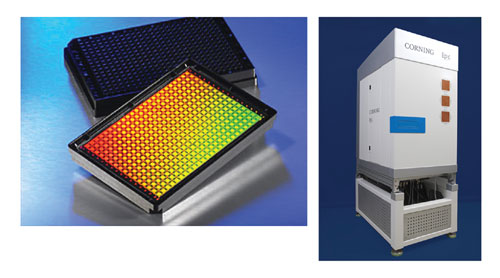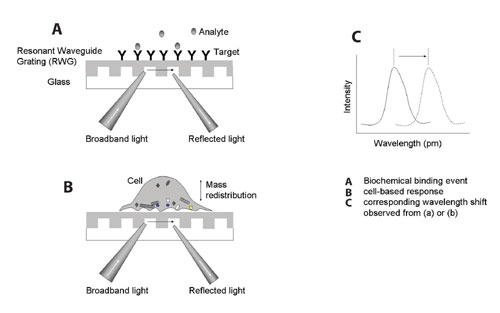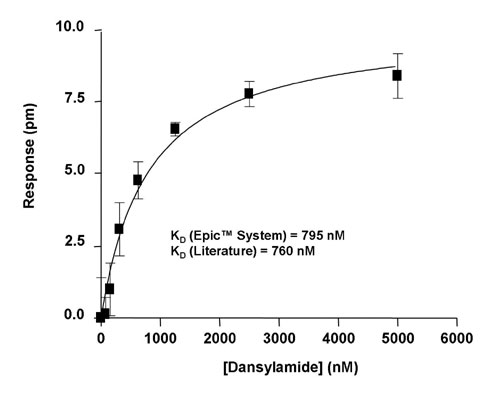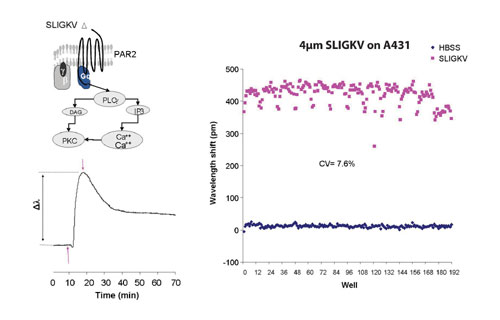September 1, 2006 (Vol. 26, No. 15)
Corning® Epic™ System Eliminates Chemical Labels and Permits Cell-based Screening
The R&D productivity gap, or the increasing amount of pharmaceutical R&D spending relative to the number of new drug candidates introduced per year, has been widely discussed in the industry and media. Many companies are responding by reexamining the tools, techniques, and practices used in drug discovery and development. This introspection has highlighted the need for more physiologically relevant technologies, particularly in discovery.
Today, much of the discovery process revolves around high-throughput screening (HTS) techniques, and a multibillion-dollar industry has appeared to supply researchers with a broad range of solutions. HTS has matured to the point where approximately half of all assays performed are cell-based and the remainder biochemical.
Despite the large number of available tools, important limitations persist for both assay classes. For example, biochemical assays frequently rely on fluorescent or radioactive labeling techniques that present a number of possible pitfalls.
In particular, labels can interfere with the interaction between analyte and target, producing misleading results. Labels are often difficult or tedious to properly affix and, in still other cases, the natural ligand for a given target may not be known.
Solutions providers have developed a range of label-free technologies to address the limitations associated with labels, but thus far these solutions have been unable to achieve the throughput needs of modern discovery programs.
Similarly, many cell-based assays require development (or licensing) of engineered cell lines that over express a target of interest to provide a sufficiently large signal response for detection with the available technologies. While use of these highly engineered cell lines enables the detection of a response, it comes at the expense of making the resulting assay less physiologically relevant to the disease being investigated.
Corning® Epic™ System
The current industry context combined with the preceding limitations has created the clear need for an HTS technology that is more physiologically relevant and Corning (www.corning.com) has developed the Epic™ System to help address this need.
The product consists of two basic components: a disposable 384-well microplate and an optical reader (Figure 1). The disposable microplate contains an integrated optical biosensor in each well and is compatible with SBS standards. The Epic reader is designed to be easily integrated with other HTS lab equipment, such as liquid handling systems, or operated as a stand-alone device. The system is capable of true HTS, enabling up to 40,000 wells read in an eight-hour period.
The operating principal behind the system relies on proven optical biosensor technology. The optical biosensor integrated into each well of an Epic microplate consists of a glass substrate with a resonant waveguide grating that is formed on top of the glass.
A dielectric waveguide coating above the grating in each well completes the biosensor.
When illuminated with broadband light, the biosensor in each well reflects a specific wavelength of light that is a sensitive function of the index of refraction close to the sensor surface. A biochemical binding event or cellular response (dynamic mass redistribution) causes a shift in the resonant wavelength that can be observed by monitoring the wavelength shift that takes place in each well (Figure 2).

Fig.1: Corning
Assay Protocols
For biochemical assays, the target of interest is first immobilized on the surface of the Epic microplate with the included surface chemistry. After immobilization, the microplate is placed into the reader for a baseline measurement. Next, the analyte is added to each well, and a second measurement is made inside the Epic reader. The wavelength shift that is observed can be used to determine whether a binding event has occurred without using labels.
Biochemical assay results are further enhanced by a patented dual sensor self-referencing technology. With this technology, each well of the microplate incorporates a nonbinding region that can be used as a reference for comparison.
The protocol for cell-based assays is quite similar to that of biochemical assays. Approximately 4,000–20,000 cells (depending on cell type and screening time) are first plated on the Epic microplate. A baseline measurement that takes approximately two minutes is performed immediately before or shortly after compound addition (depending on target type). Then a second measurement is taken and the wavelength shift can be used to determine cellular response.
The high sensitivity of the Epic optical technology makes it possible to observe cellular response at the endogenous level and without labels, providing much more physiologically relevant results than many of today’s prevailing techniques. Measuring endogenous-level cellular response has the additional advantage of eliminating the unnecessary cost or time associated with creating or licensing an over-expressed cell line.

Figure 2: Operating principle for biochemical and cell-based assays
Data Analysis
The Epic System has two basic modes of operation: assay development mode and HTS mode. Assay development mode is used to monitor the wavelength shift over time that occurs after compound addition (Figure 3) or the appropriate end-points for an HTS screen using a variety of analytical techniques. Both modes are useful for determining important parameters, such as KD and EC50 values. Once the appropriate assay parameters are determined, the Epic system can be used to conduct an HTS screen (Figure 4).

Figure3: Carbonic anhydrase binding assay.
Summary
The heightening pressure of the productivity gap in the drug discovery process has helped to expose the need for more physiologically relevant HTS technologies. Corning has helped to meet this need by developing the Epic System, which harnesses the properties of glass and light to free researchers from the pitfalls of chemical labels and permit cell-based screening at the endogenous level.

Figure 4: HTS Gq-coupled receptors with Epic System: Protease-activated receptor 2 in A431
Ronald Verkleeren is product line manager
and Anthony Frutos, Ph.D., is assay development manager, Corning® Epic™ System, Ye Fang, Ph.D., is senior research associate, biochemical technologies, L. Jack Fang, Ph.D., is senior development scientist, and Guangshan Li, Ph.D., is senior research scientist, Corning. Web: www.corning.com. Phone: (607) 974-9000. E-mail: [email protected].







